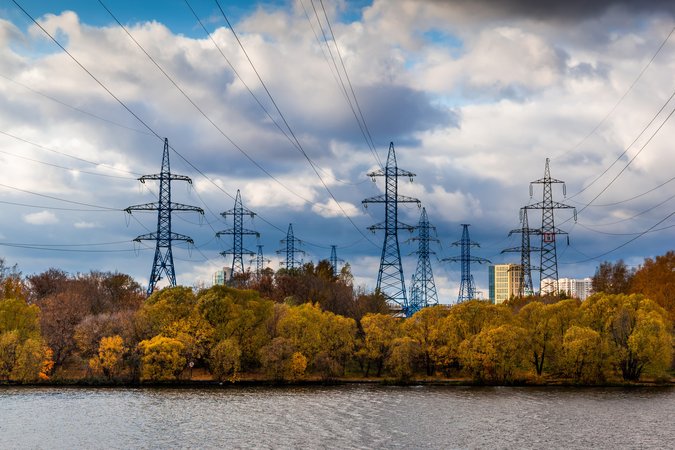Electrification 101
An overview of how electrification can reduce emissions, from the feasibility of electrifying different technologies to the policy options for encouraging economy-wide electrification.
Electrification refers to the process of replacing technologies that use fossil fuels (coal, oil, and natural gas) with technologies that use electricity as a source of energy. Depending on the resources used to generate electricity, electrification can potentially reduce carbon dioxide (CO₂) emissions from the transportation, building, and industrial sectors, which account for 65 percent of all US greenhouse gas emissions. Addressing emissions from these sectors is critical to decarbonizing the economy and, ultimately, mitigating the impacts of climate change. This explainer reviews how electrification can reduce emissions; possibilities and potential challenges of electrification in the transportation, building, and industrial sectors; and policy options for encouraging electrification.

How Can Electrification Reduce Emissions?
In the United States, over 40 percent of electricity is currently generated using zero-carbon fuels such as nuclear energy and renewables, and 35 percent is generated from natural gas, which emits the least carbon dioxide of any fossil fuel when burned. Consequently, technologies that use electricity as a fuel source result in lower carbon dioxide emissions on average than those that use fossil fuels directly. Additionally, the electricity grid is expected to become even cleaner over time as many state policies (such as Renewable Portfolio Standards) aim to increase the amount of electricity generated by zero-carbon sources. Therefore, the benefits associated with electrification will likely grow in the future as electricity generation becomes less carbon intensive.
If policymakers seek to decarbonize the transportation, building, and industrial sectors, replacing fossil fuels with electricity may also be one of the only technologically viable options. Several methods are available for decarbonizing the electricity sector, but other sectors have far fewer options available for significantly reducing emissions aside from electrification (read about different options for reducing emissions in each sector here). For example, many alternative transportation fuels (such as biodiesel and ethanol) are cleaner than gasoline, but they still emit carbon dioxide and other conventional air pollutants when burned. Hydrogen, another alternative fuel, does not produce emissions but is very expensive and requires electricity to make. Transitioning to electric technologies, which emit no emissions at the point of use, would transfer most emissions to the power sector. This would allow policymakers to focus on decarbonizing the electrical grid to reduce emissions, rather than focusing on myriad pathways like vehicle fuel efficiency requirements. Focusing on electrical grid decarbonization may be far more feasible than attempting to decarbonize each sector separately.
Notably, the benefits of electrification today vary depending on the resources used to generate electricity. Within the United States, emissions from electricity generation vary significantly. Some areas have a higher proportion of zero-carbon resources in their electricity generation portfolios and are much cleaner than regions that rely more on fossil fuels like coal. For example, the state of Washington relies on hydropower for most electricity generation and stands to benefit greatly from electrification. Wyoming, on the other hand, has a resource mix comprised almost entirely of coal with a small amount of renewables and natural gas. Consequently, the benefits from electrification in Wyoming today could be negligible, or even negative for some technologies if generating the electricity to run them creates more emissions than using fossil fuel technologies would. However, these benefits could change in the future as the grid resource mix evolves.
Potential for electrification varies greatly across and within sectors. While some sectors already have commercially ready technologies, others do not and could struggle both technologically and economically to electrify.
Electrification of the Transportation Sector
Overview
The transportation sector accounts for 29 percent of US greenhouse gas emissions (2019 data). Within the sector, 58 percent of emissions come from light-duty vehicles, 24 percent from medium- and heavy-duty vehicles, and the remainder from aircraft, ships, rail, and other sources. Given the limited electrification potential of aircraft and ships, and the small share of rail in the sector, this section will focus exclusively on electrification of light-, medium-, and heavy-duty vehicles.
For more about federal policy options to reduce transportation emissions, read “Federal Climate Policy 104: The Transportation Sector”.

Benefits of Electrification
Most light-duty vehicles (like cars, SUVs, and small trucks) run on gasoline while heavy-duty vehicles (like buses or large trucks) typically run on diesel fuel. The Corporate Average Fuel Economy (CAFE) Standards have required these vehicles to become more fuel-efficient over time, but substantially reducing emissions from vehicles will ultimately require switching to a cleaner fuel like electricity. In addition to decreasing greenhouse gas emissions, transitioning to electric vehicles can benefit the electric grid and improve air quality.
As noted above, the range of benefits of vehicle electrification heavily depends on the types of fuels used for electricity generation. For example, a car that is charged in Washington state primarily with hydroelectric power will have a lower carbon footprint than a car charged in Wyoming using power from coal plants. However, even with these considerations, driving an electric car currently produces fewer carbon dioxide emissions than a typical gasoline car when charged anywhere in the United States. The reason is that in addition to not producing tailpipe emissions, electric vehicles are also more energy-efficient fuel-efficient relative to gasoline and diesel vehicles.
Electrification of transportation can also improve air quality. Switching to electric cars and trucks can reduce air pollution where the vehicles are operating, since they do not produce tailpipe emissions. Electrification of municipal buses could also be particularly beneficial for improving local air quality. While municipal buses account for a small portion of overall transportation CO₂ emissions, they typically run on diesel fuel or compressed natural gas (CNG) and produce tailpipe emissions containing other air pollutants (like nitrogen oxides and sulfur dioxide) that contribute to poor local air quality, while electric buses do not. Switching to electric buses could improve air quality, particularly in low-income neighborhoods that rely heavily on bus lines, and therefore provide health benefits for those communities.
In addition to environmental benefits, electric vehicles could also provide benefits to the electric grid by charging when electricity is abundant and demand is low and discharging to the grid when demand for electricity is high. This capability could be particularly useful for accommodating variations in electricity production from variable renewables.
Challenges and Barriers
Widespread electrification of light- and heavy-duty vehicles faces many economic and technological challenges. Many car manufacturers already sell electric cars, but these vehicles face barriers to widespread adoption, mainly due to limited charging infrastructure and the high price tag (largely attributable to battery costs). As the number of electric vehicles grow, they could also put pressure on the local power lines by substantially increasing the amount of electricity being used.
Heavy-duty vehicles face even more obstacles to electrification relative to light-duty vehicles. Heavy-duty trucks require large batteries that take up a lot of space, limiting the space available for carrying goods. Also, trucks often travel very long distances and may require frequent charging, which adds to travel time and makes limited charging infrastructure a significant barrier. These features could limit the ability for electric trucks to substitute for fossil fuel-burning trucks unless other measures are taken to reduce charging times, such as advances in fast charging technology or battery exchange (see ICCT for more).
Electrification of Buildings
Overview
Residential and commercial buildings contribute about 13 percent of all US greenhouse gas emissions. A majority of commercial and residential buildings rely on fossil fuels—such as natural gas or oil—for space heating, water heating, and cooking.
For more about federal policy options to reduce transportation emissions, read “Federal Climate Policy 106: The Building Sector”.

Benefits of Electrification
As with vehicles, carbon emissions from buildings can be reduced by switching from fossil fuels to electricity for energy needs. Additionally, switching to electric heating and cooking technologies can have substantial air quality benefits. Some electric appliances can be better for indoor air quality than their fossil fuel-based counterparts—natural gas cooking stoves, for example, release carbon monoxide, nitrogen dioxide, and other harmful pollutants when in use.
Challenges and Barriers
Electrification of buildings is quite feasible from a technological standpoint. Commercially available electric technologies for heating and cooking currently exist, including electric heat pumps, electric hot water heaters, and electric stoves. A study done by the Lawrence Berkeley National Laboratory (LBNL) estimates that nearly the entire sector could be electrified using existing technologies; however, electrification faces economic constraints.
Economic feasibility varies geographically and by building type. For example, electric heaters (for heating both space and water) are economically competitive with existing fossil-fuel technologies in some areas of the United States (particularly the South and California). However, they struggle to achieve economic parity in other areas. LBNL claims that electric heat pumps make the most sense economically in areas with mild climates and low electricity prices. Additionally, they are more economically competitive when installed in new buildings than when they replace existing technologies in older buildings.
Electrification of the Industrial Sector
Overview
Industrial CO₂ emissions account for about 22 percent of total US greenhouse gas emissions and are predominantly from the production of materials, such as steel, cement, glass, and petrochemicals. Most of these production processes use fossil fuels for heating and as feedstock (raw material) in their processes. When heated to very high temperatures, these materials emit carbon dioxide.
For more about federal policy options to reduce transportation emissions, read “Federal Climate Policy 105: The Industrial Sector”.

Benefits of Electrification
Electricity can theoretically substitute for fossil fuels as an energy source in processes to produce some materials, such as heating required in the production of glass, paper, steel, and cement. For example, replacing natural gas furnaces with electrolytic reduction technology has the potential to significantly reduce CO₂ emissions in several industries, including textile, wood, paper, and chemicals.
Challenges and Barriers
Electrification of industrial processes faces more technological challenges than other sectors. Electrification could alter many existing processes, which could create complications, especially if the processes are intricate. Additionally, reducing emissions by replacing feedstock with non-fossil alternatives is challenging for many industries (particularly steel and cement production). Alternative feedstocks in these industries are still in early-stage research and development without commercial application.
In addition to technological challenges, electrification of industry faces economic challenges. Electrified industrial processes are currently more expensive than existing technologies to operate, as electricity is more expensive than natural gas per unit of energy.
Given these technical and economic barriers, the industrial sector may be the most difficult sector to fully electrify. In some cases, other alternatives for decarbonization might be more feasible and less expensive (such as implementing carbon capture and storage for existing processes).
Implications for Policy
Electrification is technologically feasible in many sectors, but it faces implementation challenges due to the high costs for replacing existing technologies and processes. If policymakers and electric utilities wish to reduce greenhouse gas emissions by encouraging electrification, policies and incentives that will help overcome these barriers may be needed.
Some policy incentives already exist to promote electrification, such as tax credits and rebates for the purchase of electric cars and heat pumps. While these policies can encourage a transition to electric technologies, a more economically efficient approach would be an economy-wide carbon pricing policy, such as a carbon tax or emissions cap-and-trade program, that affects all sectors rather than addressing each sector individually. If carbon dioxide emissions were priced across the entire economy, then fossil-fuel based technologies would become more expensive to operate, thus encouraging electrification of these technologies. A carbon price would also encourage fuel switching to cleaner energy sources within the electric sector, further improving the overall benefits of electrification.
If electric utilities wish to encourage electrification, they can also offer price incentives for the use of new electric technologies like cars or water heaters. For example, San Diego Gas & Electric (SDG&E) offers customers a low electricity rate specific for electric vehicle charging during off-peak hours.
Policymakers or utilities may also have to intervene to prevent potentially negative consequences from electrification. As more sectors become electrified, electric utilities may face challenges in meeting higher electricity demand, which might require infrastructure upgrades to accommodate the additional load. Alternatively, these impacts could be mitigated through other methods, such as managed charging of cars or water heating. Similarly, as the economy becomes more dependent on the electricity system rather than fossil fuel-burning technologies, policymakers and grid operators may need to take precautions to ensure that the power grid is able to maintain reliability and resilience in the face of possible power disruptions. Despite these challenges, electrification could be an effective tool for reducing carbon emissions, especially if it is encouraged through efficient policy design.




